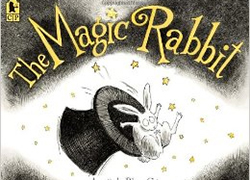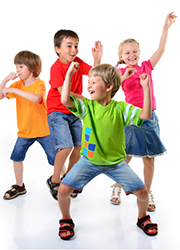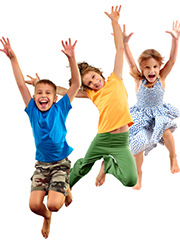SUBJECTS
GRADE
Show Results
The Magic Rabbit

Lesson Summary
- Identify different characters in a story.
- Explore movement inspired by the words in a book.
Lesson Plan and Procedure
Lesson Key Facts
- Grade(s): 1
- Subject(s): Dance, English Language Arts
- Duration of lesson: 35 minutes
- Author(s): Jana Shumway
Experience/Identify
Read The Magic Rabbit by Annette LeBlanc Cate to the children.

Teacher: Who are the main characters? Who is the story about? (Answer: Ray and the bunny.) Where are the main characters? (Answers: Downtown, a street, the park, the city, Ray’s apartment.) What are the main characters doing? (Answer: The bunny gets lost and, after searching many places, finally finds Ray.)
Explore/Investigate
The following activities represent various parts of the story that can be integrated with movement.
Activity 1: Ray
Play the song “Fairytale” by Eric Chappelle.
Have the children put one hand on an imaginary hat and the other on a hip. Have them walk and sway their heads and their torsos side to side. Have them do a full turn, then take off the imaginary hat and tilt it with their bodies. Repeat twice.
Activity 2: Bunny
Play the song “Lester Leaps In” by Count Basie.
Have the children jump all around the room, making interesting floor patterns. Let them pretend to wiggle a tail or create ears with their hands as they jump.
Activity 3: Best Friends
Play the song "Les Toreadors" from Carmen Suite No. 1 by George Bizet.
Have the children find a partner. Have one partner represent Ray and the other partner represent the bunny.
Have the partner representing Ray make a big wand action with his or her whole arm and point it at an imaginary hat, saying, “Abra cadabra ala cazam!” The student representing the bunny will then jump around.
After that, have the students representing Ray keep saying “abra cadabra ala cazam,” turning the bunny into the following: a bird (soar), a slow turtle (slow-motion crawl), a scarf (twisting and turning), and finally a choice of their own. Each time the bunny is turned into a new animal or object, the student representing it changes his or her movement.

Note: You will likely need to demonstrate this activity with a student before having students perform it themselves.
Activity 4: Crash
Use the drum.
Have the students swirl and twirl with flailing arms as they run toward a designated wall. Then, before they get to it, have them drop down into a low shape. Repeat.
Activity 5: Lost (Street)
Play the song “Caribbean Leaps" by Eric Chappelle.
Teacher: The bunny traveled to find Ray by first crossing a street.
Have the boys make cars by holding onto a steering wheel and having a partner hold onto their shoulders. Have the boys in the cars weave around the gym in curving pathways. Have the girls jump like the bunny as they weave between the cars.
Activity 6: Sidewalk
Teacher: After the bunny got across the street, he traveled along the sidewalk. But because he was so small, he could only see the legs and feet of the people.
Have the boys lie down and stick their feet up in the air and wiggle and dance them around. Have the girls move through and jump over their legs.

Activity 7: Park
Read parts of the story while the children perform the various movements.
Play the song “Parade of the Wooden Soldiers” by Arthur Fielder.
Teacher: Now, when the bunny got to the park, he first jumped over the park benches.
Have the children pretend to be jumping over benches.
Teacher: Then he circled around the big trees.
Have the children pretend to be running and circling trees.
Teacher: Then he zigzagged around the people.
Have the children zigzag around the room, dodging people.
Teacher: Then he climbed the ladder to the slide to look for Ray.
Have the children pretend to climb.
Teacher: When he couldn’t see Ray, he slid down the slide.
Have the children start running high and end low on their stomachs.
Teacher: Then he continued to jump through the park.
Have the children jump around the room.
Activity 8: Nighttime
Play the song “Nocturne” by Cirque du Soleil.
Teacher: Suddenly, it got dark. Bunny looked up and couldn’t see the sun anymore. He could only see the moon. He felt sad and lonely.
Have the children let their heads and arms go droopy. Have them droop until they are on the floor.
Teacher: He ate some popcorn, and then he noticed the stars.
Activity 9: Follow the Stars
Use the drum.
Teacher: Bunny followed the glittering stars on the ground.
Have the boys make star shapes and have the girls jump from star to star. Switch roles.
Teacher: Where did the stars lead Bunny? They led him. . . .
Down the alley (walking sideways very narrowly).
Along the street (skip).
Up the hill (walking low to the ground, and then high with hands in the air).
Down the stairs (quick steps, getting lower and lower to the ground with matching sharp arms).
Through the subway (go through a bridge made by two children).
Into the hat (big jump, then small shape).
Activity 10: Find Bunny
Teacher: Just then, Ray came out and found his hat. When he picked it up, to his surprise, he found the bunny.
Have all the children do a big jump from their shape.
Activity 11: Happy Dance
Play the song “Happy Together” by Simple Plan.
Teacher: They were both so happy; they did a happy dance.
Have the children find their partner and do a happy dance with him or her. Anything goes.
Activity 12: Going Home
Play the song “Young Man’s Fancy” by George Winston.
Have the partner representing Ray put one arm on the shoulder of their partner representing the bunny and walk around the room together.
Connect/Analyze
Review the questions you discussed earlier.
Teacher: Who are the main characters? Who is the story about? (Answer: Ray and the bunny.) Where are the main characters? (Answers: Downtown, a street, the park, the city, Ray’s apartment.) What are the main characters doing? (Answer: The bunny gets lost and, after searching many places, finally finds Ray.)
Mention the fact that nouns and verbs are in all books. Discuss what nouns and verbs are. Identify several nouns and verbs in the book.
Have the children make shapes for different nouns in the book and follow the actions of the verbs. Show the pages that the nouns and verbs are on.
- Nouns: park, hat, Ray, bunny, home, people, legs, cars, trees, slide, park bench, star, popcorn
- Verbs: jump, explode, hide, crawl, blow, walk, fly, wiggle, crash, fall, twirl, climb, reach, sneak, shrink
If there is time, have the children create sentences from the nouns and verbs they just used and dance out those sentences.
Learning Objectives
- Describe characters, events, and settings in a story.
- Utilize nouns and verbs within a sentence.
- Demonstrate locomotor and non-locomotor movements.
- Make shapes that show contrast.
Utah State Board of Education Standards
This lesson can be used to meet standards in many grades and subject areas. We will highlight one grade’s standards to give an example of application.
Grade 1 English Language Arts
Standard 1.R.7:
Describe characters, settings, and important events in a story (RL) or pieces of information in a text. (RI)
Grade 1 Dance
Standard 1.D.P.2: Make still and moving body shapes that show contrast.
Standard 1.D.P.4: Demonstrate locomotor and non-locomotor movements.
Equipment and Materials Needed
- Cate, Annette. The Magic Rabbit. London: Walker, 2008.
- Drum
- Music tracks:
- “Fairytale” by Eric Chappelle
- “Lester Leaps In” by Count Basie
- “Les Toreadors" from Carmen Suite No. 1 by George Bizet
- “Caribbean Leaps” by Eric Chappelle
- “Parade of the Wooden Soldiers” by Arthur Fieldler
- "Nocturne” by Cirque du Soleil
- “Happy Together” by Simple Plan
- “Young Man’s Fancy” by George Winston
Additional Resources
ignore
Image References
Image 1: The Magic Rabbit by Annette LeBlanc Cate (https://www.abebooks.com/9781406313512/Magic-Rabbit-Annette-LeBlanc-Cate-1406313513/plp).
Image 2: The Magic Rabbit by Annette LeBlanc Cate (https://www.amazon.com/Magic-Rabbit-Annette-LeBlanc-Cate/dp/0763666858).
Image 3: Shutterstock (https://www.shutterstock.com/image-photo/happy-children-dancing-on-white-background-141379912).
Image 4: Shutterstock (https://thumb1.shutterstock.com/display_pic_with_logo/344920/520268437/stock-photo-group-of-happy-cheerful-sportive-barefoot-children-kids-jumping-and-dancing-kids-group-portrait-520268437.jpg).

www.education.byu.edu/arts/lessons
 Download
Download